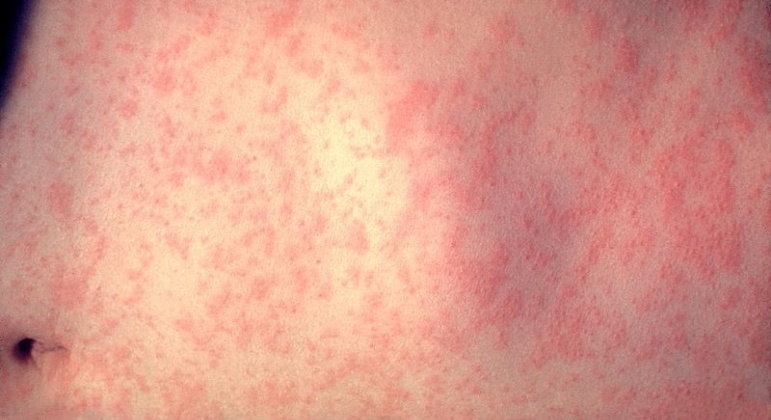Two cases of measles in São Paulo, one in the capital and one in the city of São Vicente, on the state’s southern coast, have reconfirmed fears that had lurked in the two years of the novel coronavirus epidemic: the possibility of a new outbreak as it did in 2019.
According to the Ministry of Health, there were 18,203 confirmed cases and 15 deaths in the country that year. As a result, Brazil lost the disease eradication certificate, which was granted by the Pan American Health Organization (PAHO) in 2016.
For Juárez Cunha, president of the SBIm (the Brazilian Society for Immunization), the social distancing imposed by Covid-19 gave the idea that the measles outbreak had been resolved, however, that was not real.
“The numbers are down as a result of the non-pharmacological measures that have been adopted for Covid-19, because measles is also transmitted by a respiratory method, but we continue to have an outbreak in the country. We still have cases in São Paulo and Amapá, even during the pandemic, the trend is for this situation to increase now.” ‘, warns the pediatrician.
The only way to combat the disease is through vaccination, which in Brazil has recorded a decline in coverage. Data from DataSUS (Information Department of the Unified Health System) shows that in the past year just over 49% of the population received two doses of measles vaccination – the ideal figure is 90% of the population.
“This means that we have a very significant number of susceptible children that are accumulating year after year, because this decrease has been observed for several years now. In addition to many adults who have not been vaccinated because at the time they did not have the vaccine or simply because they did not adhere to with the vaccination campaign,” explains Juárez Cunha.
To get an idea of the poor adherence to vaccination in the country, this year’s campaign began on April 3 and so far the number of applied doses has not reached 400 thousand. The Ministry of Health estimates that 18,822,908 Brazilians are eligible to receive the vaccination.
An infected person can transmit the disease to up to 18 people who are not immune.
The main concern in the low vaccination scenario is due to the high rate of disease transmission. In a susceptible population, each confirmed case can infect at least 12 people and a maximum of 18 people.
“It is considered one of the most contagious diseases that you have. So, if you are in an environment where someone has measles with people who are not immunized or people who have not had measles, the tendency is to infect everyone there. It has a transmissibility of up to 18 times,” stresses the chief SBI.
Satisfaction was identified as the main factor for low vaccination coverage. “The idea that people have diseases they don’t know, haven’t seen before, and don’t need to be vaccinated leads to these low rates,” the doctor laments.
However, it is important to remember that measles remains the leading cause of death for children in less developed countries, despite the existence of a safe vaccine since 1963.
“It can have very serious consequences, it can lead to death, hospitalization, it can have sequelae – and we have a safe, effective and free vaccine,” encourages the specialist.
Who can get the vaccine?
According to SBIm, people who have received two doses of the vaccine, at least one month apart, from the age of one year, are considered immune. The Ministry of Health provides vaccinations in health centers for people up to the age of 59, but there is no age limit for receiving the injection.
“There is no age limit for vaccinating. The Ministry states that the age is 59, because the chances of people aged 60 or over contracting measles in childhood are very high, because it was a disease that almost everyone had when they contracted measles. They did not. There hasn’t been a vaccine yet,” Cunha explains.
However, the expert notes that “in outbreaks, for example, when someone has measles in the work environment, all people who have not been vaccinated or do not know if they should receive the application, even those over the age of 59 General…”
Immunization is indicated for individuals aged one year and both doses should be administered at least for one month. Anyone who is not sure they have received both applications can be vaccinated again.
“There are no contraindications to giving the vaccine to anyone who has previously received the vaccine or to people who have measles.”
In the case of women, the indication is pregnancy one month after receiving the injection and not being vaccinated during pregnancy. Immunosuppressed people should receive protection only with medical permission, because the antigen is made from a live, attenuated virus.
Individuals who have already contracted the disease with a diagnosis confirmed by physicians and who have already received both doses do not need to receive the immunizing agent.
What are the symptoms of measles?
According to Opas, the first signs of the disease are a high temperature, which may appear with secretions in the nose, coughing, redness in the eyes and tears. Small white spots inside the cheeks can also appear at an early stage.
More than a week after exposure to the virus, rashes appear, usually on the face and upper neck. Within three days, the spots spread, eventually reaching the hands and feet. It lasts five to six days.

“Wannabe internet buff. Future teen idol. Hardcore zombie guru. Gamer. Avid creator. Entrepreneur. Bacon ninja.”

